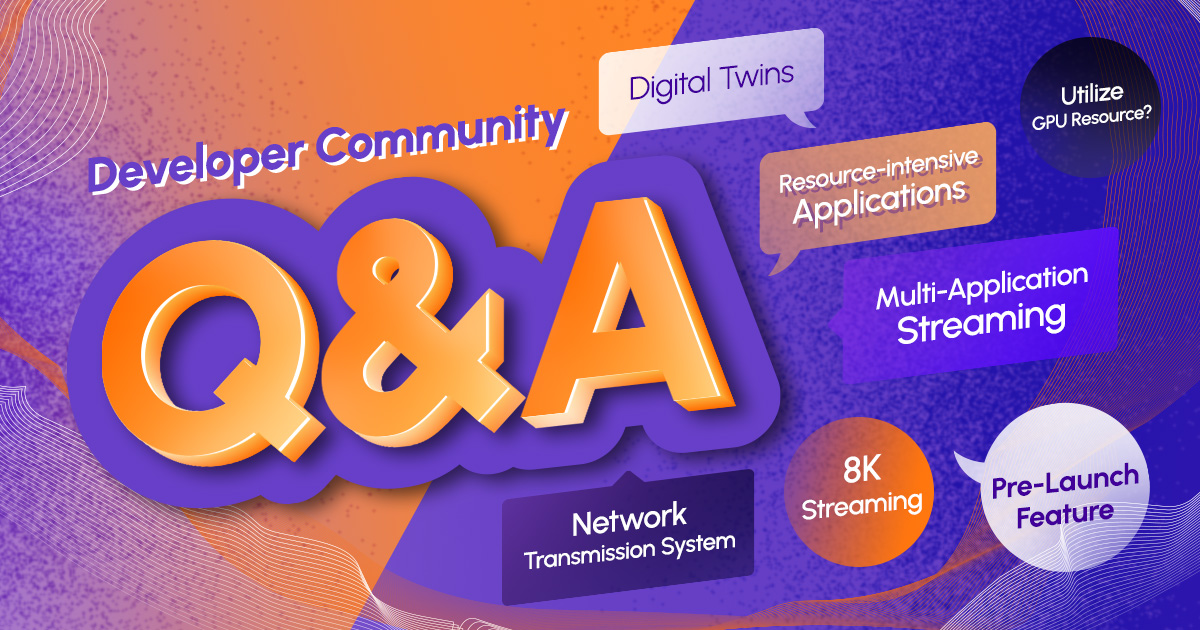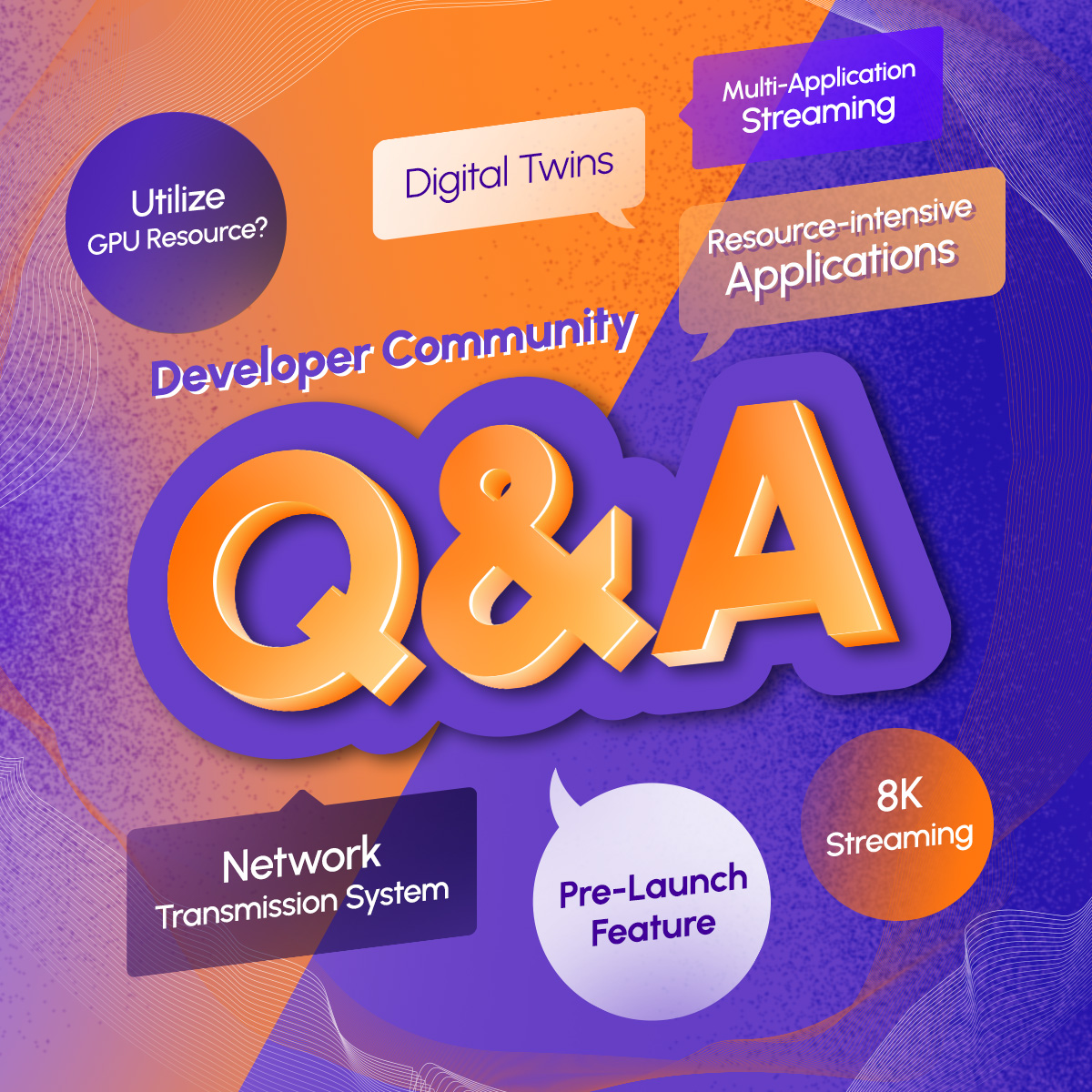

Welcome to the Developer Community Q&A
Dive into the forefront of innovation with Paraverse’s cutting-edge 3D XR cloud streaming technology. In this Q&A, we address critical questions from our vibrant developer community, illuminating how LarkXR is transforming the landscape of 3D XR streaming and digital twin applications. By leveraging the collective insights and curiosity of our developers, we explore the unique features that set LarkXR apart from traditional rendering solutions. Whether you’re an experienced developer or new to cloud streaming, this dialogue provides essential insights into the future of immersive, high-performance 3D applications. Join us as we tackle industry challenges and unveil unmatched benefits for developers and users alike.
Developer Community Q&A

Q
What are the core issues faced by digital twin applications in large-scale deployment with traditional solutions?
A
Digital twin applications often involve numerous high-precision models, resulting in substantial resource packages and high computational loads. Users must invest in high-performance machines to access this content, leading to elevated hardware costs and increased entry barriers.

Q
How does LarkXR address these challenges?
A
LarkXR’s cloud streaming provides an optimal solution for large-scale 3D spatial computing. By leveraging nearly infinite server-side computational power, users can access real 3D content and interact with it using lightweight terminals, achieving seamless performance without heavy local resources.

Q
What benefits does LarkXR's real-time cloud streaming solution bring to the digital twin industry?
A
LarkXR offers numerous benefits for the digital twin industry. Firstly, it significantly reduces the pressure on local terminals by shifting the computational load to the cloud, which has nearly infinite computing capabilities. This shift lowers the entry barrier for users, allowing them to access complex 3D applications without the need for high-performance hardware. Secondly, LarkXR provides universal terminal access, enabling users to experience heavy 3D applications through lightweight devices. This flexibility ensures that users can interact with high-fidelity digital twin environments seamlessly, promoting greater collaboration and efficiency in industrial applications. Additionally, LarkXR enhances accessibility and convenience, making it an ideal choice for industries relying on real-time data visualization and analysis.

Q
How can LarkXR integrate better with applications?
A
LarkXR enhances application integration by providing a comprehensive PaaS platform that simplifies application management and deployment. Our platform supports seamless integration between applications and business systems through robust APIs and SDKs. This facilitates real-time bidirectional data communication between business systems and applications, enabling users to develop custom platforms tailored to their specific needs. Furthermore, LarkXR’s architecture allows for simple implementation of hosted application solutions, ensuring that developers can rapidly integrate their applications with existing workflows. Our REST APIs provide additional flexibility, allowing developers to leverage our capabilities for customized data functionality and processes, thereby streamlining development and enhancing overall productivity.

Q
How does LarkXR optimize GPU resource utilization?
A
LarkXR optimizes GPU resource utilization by breaking through traditional vGPU and GPU passthrough solutions and incorporating resource pooling for visual GPUs, which supports both virtual and physical machines. This innovative approach allows a single machine to host multiple graphics cards, each capable of running several applications simultaneously, effectively eliminating resource waste and optimizing allocation. By utilizing containerization, LarkXR achieves process isolation and dynamic scheduling, enabling ultra-fine-grained resource management across multiple GPUs. This significantly enhances server efficiency, reduces operational costs, and boosts overall performance. Furthermore, we support WebGL applications. When not using cloud rendering, WebGL applications can use up to 94% of their GPU, but this usage is significantly reduced once cloud rendering is enabled. Users can activate WebGL applications effortlessly through lightweight terminals without downloading any content, making the user experience more convenient.

Q
While real-time cloud streaming technology reduces user costs and allows the use of lighter terminals, how does it ensure user experience comparable to local rendering, given its dependence on network conditions?
A
We recognize the reliance on network quality, which is why we developed a proprietary network transmission system. This addresses challenges related to ultra-high bitrate and complex application scenarios by optimizing for high resolution, high bitrate, and low latency. It effectively manages issues such as delay, jitter, packet loss, and bandwidth fluctuations. Our proprietary system differs from Pixel Streaming, as all underlying encoding is independently developed and continuously optimized, ensuring that the user experience closely matches local performance.

Q
What are the minimum network requirements for effective data transmission?
A
LarkXR ensures optimal network quality on both server and client sides for a seamless experience. Bandwidth requirements vary by resolution: 2K applications need about 10 Mbps, while 4K applications require around 50 Mbps, and VR applications require a minimum of 50 Mbps for smooth performance.

Q
How does LarkXR ensure seamless compatibility across various platforms and devices?
A
LarkXR achieves compatibility through a foundational runtime that supports multiple terminal types and 3D game engines, including Unreal, Unity, CryEngine, Unigine, and OSG. The design caters to XR and spatial wearables, including AR, VR, and MR headsets, enabling all SR, VR, AR, and MR applications to operate on a single, unified platform.
LarkXR is compatible with a variety of devices and operating systems, including HoloLens, smartphones, tablets, PCs, Windows, Linux, MacOS, Android, and iOS, providing true 3D experiences with ultra-high precision. Additionally, LarkXR’s API allows developers to implement hosted application solutions quickly, while our SDKs for Web, Android, Unity, Windows, and iOS ensure simple integration and extensive customization.
LarkXR is compatible with a variety of devices and operating systems, including HoloLens, smartphones, tablets, PCs, Windows, Linux, MacOS, Android, and iOS, providing true 3D experiences with ultra-high precision. Additionally, LarkXR’s API allows developers to implement hosted application solutions quickly, while our SDKs for Web, Android, Unity, Windows, and iOS ensure simple integration and extensive customization.

Q
How does LarkXR enhance user experience for resource-intensive applications?
A
LarkXR enhances the user experience by implementing pre-launch features that allow resource-intensive applications to load in advance for instant access, eliminating slow local launch times. Our off-screen rendering reduces server resource consumption, while the partial view feature dynamically retrieves specific areas for large-screen displays, minimizing bandwidth usage and improving image quality. For industrial-grade 8K control panels, LarkXR supports 8K streaming media using Chrome’s WebCodec technology, delivering high-quality visuals and immediate accessibility, making it an ideal solution for immersive experiences.

Q
How does LarkXR’s new feature support both 3D and 2D applications in a single server environment?
A
LarkXR’s Multi-Application Streaming feature transforms the way users interact with applications by enabling the rendering and streaming of multiple applications on a single server simultaneously. This significantly enhance server utilization and compatibility, making it ideal for enterprise environments with high concurrency and numerous users.
The capability supports 3D rendering from major graphics engines like UE, U3D, OSG, Unigine, and CryEngine, as well as 2D, 3D/2D hybrid, WebGL, and multi-window apps. By minimizing reliance on end-device performance, this upgrade not only simplifies user access but also encourages broader application adoption. Ultimately, it empowers LarkXR to cater to both professional 3D rendering needs and diverse 2D application scenarios, ensuring efficient multitasking capabilities and an enriched user experience.
The capability supports 3D rendering from major graphics engines like UE, U3D, OSG, Unigine, and CryEngine, as well as 2D, 3D/2D hybrid, WebGL, and multi-window apps. By minimizing reliance on end-device performance, this upgrade not only simplifies user access but also encourages broader application adoption. Ultimately, it empowers LarkXR to cater to both professional 3D rendering needs and diverse 2D application scenarios, ensuring efficient multitasking capabilities and an enriched user experience.
Stay Tuned!
Thank you for joining us in this exploration of LarkXR’s capabilities! Stay tuned for our next round of Q&A, where we will dive deeper into the questions that matter most to you and continue to unveil the future of 3D spatial computing.
